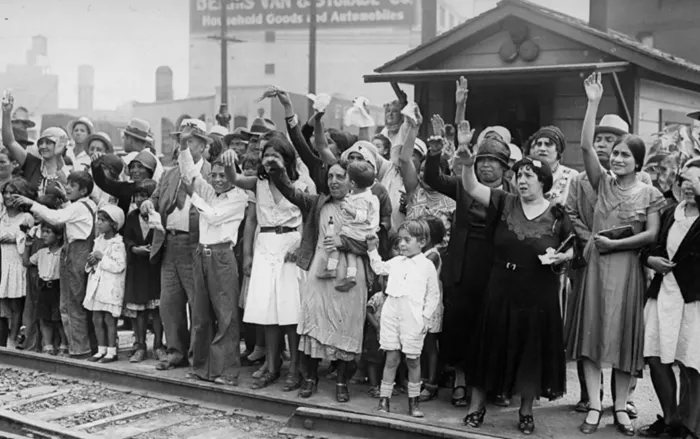Trump’s Deportation Threats and Historical Precedents.
Last month, former President Donald Trump vowed to expel one million immigrants who are legally residing in the United States. While some dismiss these threats as mere bluster, it is important to recognize that history provides a chilling precedent for such mass expulsions. During the Great Depression, many wrongly blamed Mexican immigrants and Mexican Americans for the economic downturn. As a result, nearly one million people were forcibly removed from the country, many of whom were U.S. citizens. This group became known as the “Repatriados,” and their plight has largely faded from collective memory, along with the horrors of their expulsion.
The Mexican Population in the U.S. Before the Depression
In the late 1920s, approximately 1.5 million people of Mexican descent lived in the United States. Many were not immigrants; their territory had been taken from Mexico in 1848, leaving their families in a new nation. By the time the Great Depression began, these individuals, along with newer immigrants, were spread throughout California, the Midwest, and the Southwest. Most worked in agriculture, but many also served as domestic workers or in construction.
Blame During Economic Collapse
When the economy collapsed in the early 1930s, Mexicans, along with other immigrant groups, were blamed for stealing jobs from white Americans. Severo Márquez, a native of Chihuahua, had lived and worked in the U.S. for two decades. In the early 1930s, he resided in East Los Angeles with his family while working for a contractor. However, when the contractor laid off all his Mexican workers, Márquez found himself unemployed and ultimately returned to Mexico to start anew.
Harsh Treatment of Mexican Workers
As Mexicans and Mexican Americans sought assistance, they were often met with hostility from white social workers. Many were denied relief and handed tickets for transportation back to Mexico. When searching for work, they faced discrimination, being told to leave the country for taking jobs from “Americans.” Government officials conducted aggressive raids in Los Angeles, detaining hundreds in public spaces. Authorities announced deportations through loudspeakers and advertisements in radio and newspapers. In 1931, the City of Los Angeles and the State of California passed laws prohibiting public fund recipients from hiring “aliens,” part of a broader initiative led by President Herbert Hoover that supported local restrictions.
Agricultural Workers and Expulsions
In California, white agricultural elites fueled many of the expulsions. Amid declining wages and poor living conditions, Mexican and Filipino farmworkers organized significant strikes, culminating in a successful strike by 14,000 cotton pickers in the San Joaquin Valley in 1933. In response, authorities quickly moved to deport labor activists, an event journalist Carey McWilliams described as “the rise of farm fascism.”
The Impact of Deportations
In the 1930s, the federal government officially deported about 82,000 Mexicans. However, most Repatriados were not formally deported; they were coerced into leaving through state-sanctioned repression. Throughout the early 1930s, many headed to Mexico, filling trains from Los Angeles, Arizona, and Texas, while others traveled in large groups from cities like Chicago and St. Louis. In Texas, local business owners in the Mexican community provided food and organized donations to help the migrants.
The Migration of White Workers
During the same period, a significant migration of white individuals from Arkansas, Oklahoma, Texas, and other Southwest regions filled the labor void left by Mexican and Mexican American workers. Many viewed these new arrivals as symbols of suffering during the Depression. In the years that followed, the wartime economy pulled them into factory jobs. However, the demand for agricultural labor persisted, leading to the establishment of the bracero program in 1942, which exploited “guest workers,” including some of those previously expelled.
Family Disruption and Return to Mexico
Most Repatriados returned to their original communities and families in Mexico. However, many older children chose to remain in the U.S., leading to family separations. Those who returned faced cultural shock, as their new homes often lacked basic amenities, and some children did not speak Spanish. While some returned to the U.S. after the war, many were unable to do so due to lack of documentation.
Renewed Attention and Historical Acknowledgment
In the 1970s, Chicano historians began to spotlight the experiences of the Repatriados, conducting interviews that revealed deeply buried trauma. These efforts contributed to California’s Apology Act for the 1930s Mexican Repatriation Program, which was officially recognized in 2006. Today, the history of the Repatriados is preserved in Mexican American studies, resonating across borders.
The Need for Vigilance Today
As we witness Trump’s threats of mass deportation today, it is vital to take them seriously. By honoring those who experienced the expulsions of the 1930s, we can resist these dangerous proposals and work to ensure that the atrocities faced by the Repatriados are never repeated.
Dana Frank is a professor of history emerita at UC Santa Cruz and the author of “What Can We Learn From the Great Depression? Stories of Ordinary People and Collective Action in Hard Times.”
Related topics:
- Claims of Immigrants Eating Pets Are Nonsense That Divide Americans
- Putin Increases Visa-Free Access for Georgians in Russia
- Poland Strengthens Visa Regulations Following Investigation into Previous Government’s Cash-for-Visa Scandal


